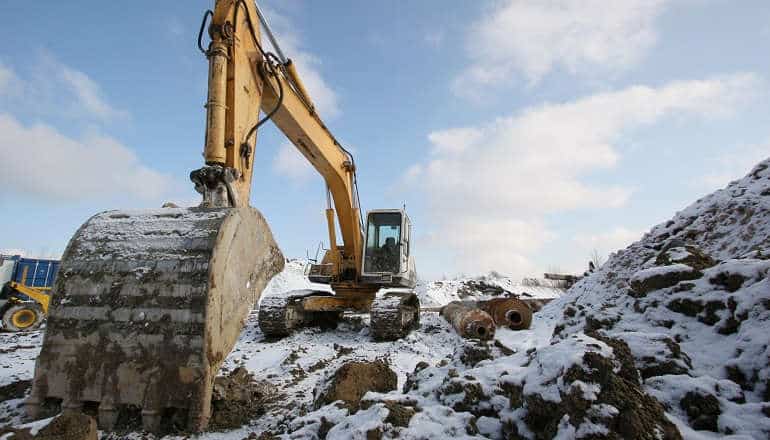7 Winter Weather Safety Tips for Contractors
 By Emily Newton
By Emily Newton
Cold weather can create significant safety problems for contractors — especially those who work outdoors or in unheated structures. In addition to frigid temperatures, workers may also be at greater risk of slips and falls due to the buildup of snow or ice.
These winter safety tips will help contractors work through the season safely and with less risk of injury due to cold or inclement weather.
1. Dress for the Cold
Without the right clothing, the core temperatures of workers exposed to the cold can drop quickly, putting them at risk of hypothermia and other illnesses.
OSHA recommends layering to protect workers from the cold — specifically, “at least three layers of loose-fitting clothing.” The agency suggests an inner layer made from wool, silk or synthetic material to wick moisture away from the body, a middle layer to provide insulation, and an outer layer that offers rain and moisture protection. The outer layer should allow for some ventilation — it should either be made from a breathable material or be opened.
Layering clothes is one of the best ways to provide some insulation from the cold, and loose-fitting items won’t restrict blood flow, helping your body keep itself warm.
These layers protect your core from the cold but may not provide insulation to your hands, feet and head. Wearing a face mask, proper work boots and insulated gloves will help prevent frostbite and damage to your extremities.
Contractors should ensure they follow these recommendations and that their employees know what they should wear to stay safe. If necessary, providing the right cold-weather clothing can help protect workers from winter temperatures.
2. Protect Against Moisture
Moisture is another major threat to winter construction safety. Wet clothing “greatly increases heat loss through conduction and evaporation,” according to the University of Michigan. Even workers dressed for the winter can become dangerously cold if their clothing becomes wet.
Water-resistant clothing is key to ensuring workers are fully protected from winter weather. Ideally, only the outer layer should be waterproof or water-resistant, as inner waterproof items can trap moisture against the body.
Additionally, gloves and boots should be waterproof or water-resistant if necessary.
Workers in wetter climates may need more protection than others, but everyone should have some kind of protection against winter moisture. Outdoor staff may also need more protection than people working indoors or in areas that offer some protection from ice, snow and hail.
3. Remove Snow and Ice
Slips, trips and falls, account for one of OSHA’s Fatal Four — the four most common causes of workplace injury and death. These four are some of the most significant hazards workers face in construction and manufacturing.
Snow and ice can create conditions that make slips and falls more likely. Ice can cause workers to slip on walkways and make ladders slide or fall, potentially throwing workers to the ground. Removing snow and ice from work areas and walkways helps prevent these incidents.
Line and cable workers, who regularly work at height, are especially at risk. Contractors managing these employees should take special care to keep them safe from threats posed by ice and snow.
4. Create a Space for Warming Up
Even with the right clothing, workers may become dangerously cold after several hours in winter temperatures. For this reason, contractors may need to provide employees with a space to warm up. If workers are going to spend a great deal of time outdoors without a chance to get warm, there should be a dedicated, heated space where they can spend breaks.
Most businesses have access to different heater options, including direct and indirect fired heaters. Both can provide the warmth workers need to prevent hypothermia and cold stress.
Businesses should use these heaters safely. They can create additional fire risks that a contractor will need to manage, and gas-powered heaters will need some kind of ventilation that ensures gas does not build up in the break area.
5. Train Employees to Recognize Cold Stress
Even with these precautions, workers may still be vulnerable to hypothermia and conditions like cold stress — especially if they have underlying conditions, like Type 1 or 2 diabetes, that can disrupt body temperature regulation.
All workers should be trained to recognize the symptoms of cold stress and hypothermia, including:
- Low body temperatures
- Shivering, or stopping of shivering as hypothermia progresses from mild to moderate
- Confusion
- Slurred speech
- Slow breathing or heartbeat
- Loss of consciousness
Knowledge of these symptoms will help workers identify when others around them are beginning to suffer from hypothermia.
An emergency response plan that employees can follow when a co-worker develops symptoms can help a team effectively respond to cold stress and similar conditions. Resources like the OSHA quick card or relevant posters can be used as workplace reminders of cold stress symptoms.
6. Minimize Worker Exposure to Freezing Temperatures
Ideally, workers should spend as little time exposed to the cold as possible. Contractors may need to work outside for a project, but they should return inside or to a heated area when outdoor work is not strictly necessary.
Clothes can protect against the cold, but reducing exposure is the best way to keep workers safe.
7. Use Insulated Tools
Tools without proper insulation can freeze and become brittle in cold weather. They may break or become hard to operate, requiring workers to exert more force than needed.
Air and cordless power tools can be especially vulnerable to extreme temperatures. Batteries may discharge faster and charge slower in winter weather. Extremely low temperatures can also damage the battery, reducing its total possible charge or disabling it entirely.
Requiring workers to properly store tools when not in use will help protect them from the cold. Using insulated tools can also minimize the risk of damage.
Best Practices for Winter Construction Safety
While low temperatures and winter weather may pose safety risks, electrical contractors can work safely in the cold with the right practices.
Winter clothing, water-resistant PPE and insulated tools protect workers at the individual level. Changes to a job site — like removing snow or ice and installing heaters — provide broader worker protections. Take steps to keep employees safe until spring finally rolls around again.





